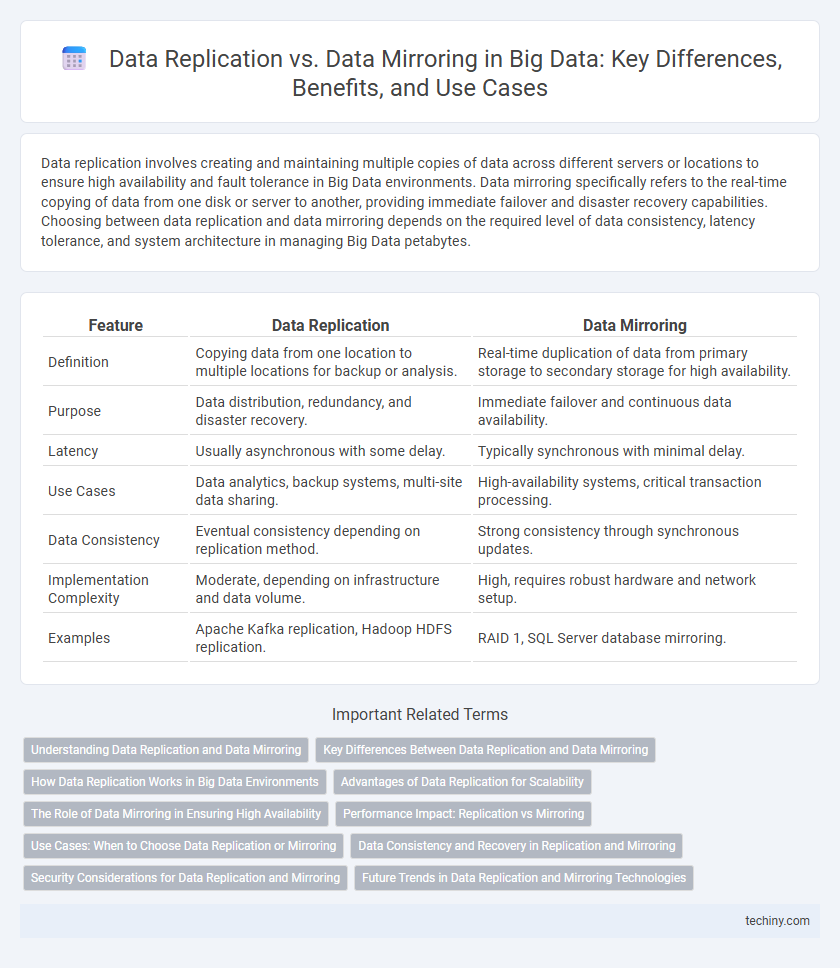Data replication involves creating and maintaining multiple copies of data across different servers or locations to ensure high availability and fault tolerance in Big Data environments. Data mirroring specifically refers to the real-time copying of data from one disk or server to another, providing immediate failover and disaster recovery capabilities. Choosing between data replication and data mirroring depends on the required level of data consistency, latency tolerance, and system architecture in managing Big Data petabytes.
Table of Comparison
| Feature | Data Replication | Data Mirroring |
|---|---|---|
| Definition | Copying data from one location to multiple locations for backup or analysis. | Real-time duplication of data from primary storage to secondary storage for high availability. |
| Purpose | Data distribution, redundancy, and disaster recovery. | Immediate failover and continuous data availability. |
| Latency | Usually asynchronous with some delay. | Typically synchronous with minimal delay. |
| Use Cases | Data analytics, backup systems, multi-site data sharing. | High-availability systems, critical transaction processing. |
| Data Consistency | Eventual consistency depending on replication method. | Strong consistency through synchronous updates. |
| Implementation Complexity | Moderate, depending on infrastructure and data volume. | High, requires robust hardware and network setup. |
| Examples | Apache Kafka replication, Hadoop HDFS replication. | RAID 1, SQL Server database mirroring. |
Understanding Data Replication and Data Mirroring
Data replication involves copying data from one location to multiple destinations to ensure consistency and availability across distributed systems in Big Data environments. Data mirroring creates an exact real-time copy of data, primarily for backup and disaster recovery purposes, maintaining synchronous or near-synchronous updates between the source and mirror. Both techniques enhance data resilience and fault tolerance but differ in latency, use cases, and system architecture integration.
Key Differences Between Data Replication and Data Mirroring
Data replication involves copying and maintaining database objects in multiple locations to enhance data availability and scalability, whereas data mirroring creates an exact real-time copy of a single database for high availability and disaster recovery. Replication supports distributed data processing and can be asynchronous or synchronous, while mirroring typically operates synchronously to ensure data integrity and immediate failover. Key differences lie in their use cases: replication for load balancing and distributed analytics, mirroring for fault tolerance and system redundancy.
How Data Replication Works in Big Data Environments
Data replication in big data environments involves copying and maintaining data across multiple nodes or clusters to ensure data availability, fault tolerance, and load balancing. The process uses asynchronous or synchronous techniques to synchronize data changes in real-time or near-real-time, enabling distributed analytics and disaster recovery. Efficient data replication minimizes latency and optimizes resource utilization by selectively duplicating datasets based on access patterns and consistency requirements.
Advantages of Data Replication for Scalability
Data replication enhances scalability by distributing data copies across multiple servers, allowing simultaneous read and write operations that improve system performance and fault tolerance. It supports load balancing by directing user requests to the nearest or least busy server, reducing latency and preventing bottlenecks. This method ensures continuous data availability and quick recovery in big data environments, making it ideal for scalable, distributed architectures.
The Role of Data Mirroring in Ensuring High Availability
Data mirroring plays a crucial role in ensuring high availability by creating exact, real-time copies of data across multiple servers or locations, minimizing downtime during system failures. Unlike data replication, which may occur asynchronously or involve transformations, data mirroring operates synchronously to provide immediate data consistency and fast failover capabilities. This seamless redundancy enhances fault tolerance and supports continuous access to critical Big Data applications and services.
Performance Impact: Replication vs Mirroring
Data replication improves Big Data system performance by distributing data across multiple nodes, enabling parallel processing and enhancing fault tolerance. Data mirroring primarily focuses on creating real-time copies for high availability, which can introduce latency due to synchronous updates. Replication's asynchronous nature offers better throughput and scalability compared to mirroring's immediate consistency model.
Use Cases: When to Choose Data Replication or Mirroring
Data replication suits scenarios requiring asynchronous backup and disaster recovery, ensuring data availability across distributed systems with minimal latency impact. Data mirroring is ideal for high-availability environments demanding real-time synchronization and instant failover, such as critical transaction systems and financial services. Enterprises managing multi-site data centers benefit from replication to maintain consistency, whereas those prioritizing zero data loss select mirroring for mission-critical applications.
Data Consistency and Recovery in Replication and Mirroring
Data replication ensures data consistency by maintaining multiple synchronized copies across distributed systems, enabling efficient recovery through failover mechanisms and minimizing data loss. In contrast, data mirroring duplicates data in real-time, providing immediate consistency and rapid recovery by switching to mirror sites without data lag. Both strategies enhance fault tolerance, but replication offers flexibility in asynchronous updates while mirroring excels in synchronous data consistency and instant recovery.
Security Considerations for Data Replication and Mirroring
Data replication enhances security by creating multiple data copies across distributed systems, improving fault tolerance and minimizing data loss during breaches or failures. Data mirroring, which involves synchronous copying of data to a secondary location, offers real-time redundancy and rapid recovery but may increase exposure to security risks if both mirrors are compromised simultaneously. Implementing encryption, access controls, and regular audits are essential to safeguard replicated and mirrored data against unauthorized access and ensure compliance with data protection regulations.
Future Trends in Data Replication and Mirroring Technologies
Emerging trends in data replication and mirroring emphasize increased automation, real-time synchronization, and enhanced fault tolerance to support escalating Big Data workloads. Advances in AI-driven replication management optimize data consistency across distributed systems while minimizing latency and bandwidth consumption. Future technologies prioritize seamless integration with cloud-native architectures and hybrid environments, ensuring scalable, resilient, and cost-effective data availability.
Data Replication vs Data Mirroring Infographic

 techiny.com
techiny.com